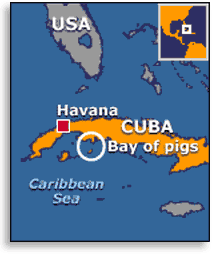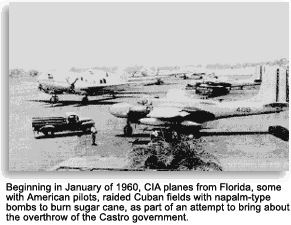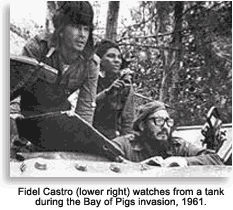The Bay of Pigs invasion was intended to provoke popularity for an uprising against Fidel Castro, who had overthrown American-backed dictator Fulgencio Batista. Instead, it gave Castro a military victory and a permanent symbol of Cuban resistance to American aggression.
The Bay of Pigs was not originally John F. Kennedy's idea. As the communist nature of Fidel Castro's regime became apparent, the urge to topple his government grew. Dwight D. Eisenhower's administration planned the invasion, which would be handled by the CIA. By the time of Kennedy's inauguration, the order to invade was the only remaining piece of the plan to put into place.
 Planning for the invasion began in 1960, before diplomatic ties with Cuba had been broken. The situation was delicate, since the plan was to overthrow a government with which the United States was not at war. Various aspects, including propaganda and military strategies, were included in the plan, along with the directive that the U.S. should not appear to be involved.
Planning for the invasion began in 1960, before diplomatic ties with Cuba had been broken. The situation was delicate, since the plan was to overthrow a government with which the United States was not at war. Various aspects, including propaganda and military strategies, were included in the plan, along with the directive that the U.S. should not appear to be involved.
During the presidential campaign, Kennedy had accused Eisenhower of not doing enough about Castro. In fact, Eisenhower might have launched an invasion himself, had a proper excuse presented itself. Instead, he bequeathed an advanced plan to Kennedy, who was strongly inclined to pursue it.
Others in the government were not convinced. The Cubans had presented evidence to the United Nations as early as October that the United States was hiring and training mercenaries. American involvement was not likely to remain much of a secret.
Senator J. William Fulbright told Kennedy that this sort of hypocrisy was just the sort of thing of which the United States accused the Soviets. Under Secretary of State Chester Bowles advised Secretary of State Dean Rusk that the plan was wrong on both moral and legal grounds. Those in favor of the plan also included former Vice President Richard Nixon, John's brother Robert F. Kennedy, and Secretary of Defense Robert S. McNamara.
On April 12, 1961, Kennedy told a press conference that the United States unequivocally had no intention of intervening in Cuban affairs. Five days later, the invasion took place.
 The invasion force had been assembled in Guatemala. It departed in six ships from a port in Nicaragua on April 14. On April 15, the American-backed Cuban exiles began to bomb airfields near two points in the Bay of Pigs and the Zapata swamps in Cuba.
The invasion force had been assembled in Guatemala. It departed in six ships from a port in Nicaragua on April 14. On April 15, the American-backed Cuban exiles began to bomb airfields near two points in the Bay of Pigs and the Zapata swamps in Cuba.
In a clumsy effort to make the attacks appear to have been made by defectors, the attacking B-26 airplanes were disguised to look like Cuban aircraft. An actual defector named Mario Zúñiga was presented to the press along with his airplane, but so many important details were missing and the press had uncovered so much of the truth, that the cover-up effort had little success.
Within the first few hours of the operation, it began to appear that the invasion would fail because it had not garnered the support from locals on which they were counting. Much to the CIA’s surprise, locals firmly supported Castro and the Revolution.
Adlai E. Stevenson, the American ambassador to the U.N., flatly denied the Cuban ambassador's charges about the attack and showed the official photographs to support the defector’s story. Unfortunately, the truth came out within a few hours and Stevenson was humiliated. He also learned that Kennedy had referred to him as “my official liar.”
The attack began shortly after midnight on April 16. Coral reefs, misidentified by U-2 spy planes as seaweed, held up landings. Two ships were stranded 80 yards from shore and some heavy equipment was lost. With the invasion plainly underway, Rusk announced on Monday, April 17, that the U.S. would not intervene in Cuba nor would it in the future.
Because world opinion was against the U.S., Kennedy decided not to provide further air cover until it could be launched from a landing strip somewhere in Cuba. This never happened, and Cuban forces had complete control of the air. A final desperate attempt at air support resulted in the loss of four American airmen on April 19, but the outcome was already sealed.
 The invaders surrendered on the afternoon of April 19. More than 200 people been killed; another 1,197 were taken captive. On April 20, Kennedy told the American Society of Newspaper Editors that the episode was Cubans fighting Cubans and that the U.S. had not been involved.
The invaders surrendered on the afternoon of April 19. More than 200 people been killed; another 1,197 were taken captive. On April 20, Kennedy told the American Society of Newspaper Editors that the episode was Cubans fighting Cubans and that the U.S. had not been involved.
A few months later, the three responsible for planning the invasion — Director of Central Intelligence (DCI) Allen Dulles, Deputy Director of Operations Richard Bissell, and Air Force General Charles Cabell — were fired.
Mass trials of the captured men were held and nearly all were sentenced to 30 years imprisonment. After 20 months of negotiations, they were released in exchange for $53 million in food and medicine.
The failure of the Bay of Pigs Invasion set the stage for further aggressions against Castro from his northern aggressor. President Kennedy made little effort to conceal his continued desire to see Castro deposed. Castro’s insecurity about the future of his rule over Cuba led to the installation of Soviet nuclear missiles there, prior to the Cuban Missile Crisis of 1962.